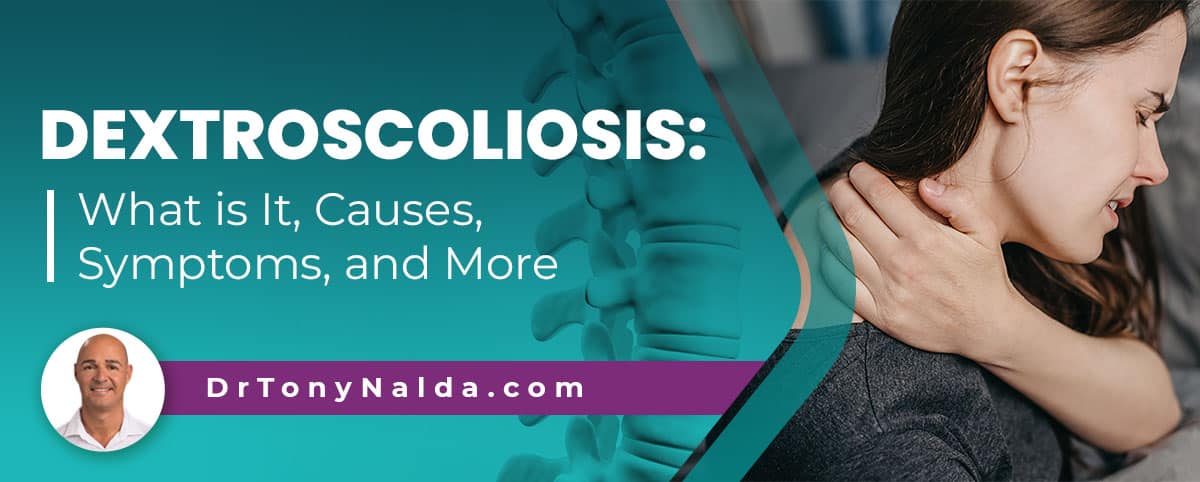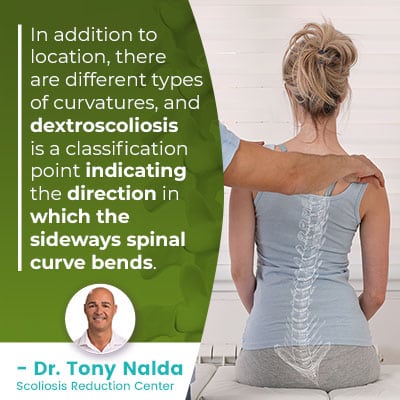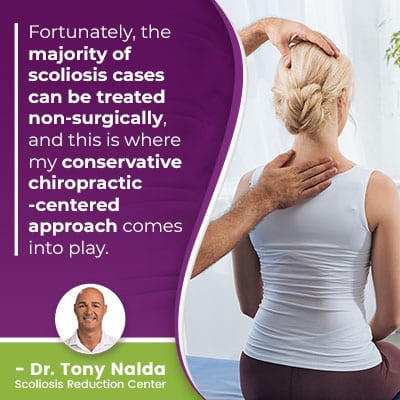Dextroscoliosis: What is It, Causes, Symptoms, and More

There are different types of scoliosis and scoliotic curves. In typical cases, the curve bends to the right, away from the heart; this is dextroscoliosis. When a scoliotic curve bends to the left, towards the heart, this is levoscoliosis and is considered atypical.
Scoliosis involves the development of an unnatural sideways spinal curve, with rotation and a Cobb angle measurement of 10+ degrees. Dextroscoliosis is a further specification that indicates the curve bends to the right, away from the heart; this is considered a typical scoliosis.
Let’s start our discussion of dextroscoliosis by touching on some general information about scoliosis, including why and how it’s classified.
What is Scoliosis?
Scoliosis is the development of an unnatural sideways spinal curve, with rotation, and a minimum Cobb angle measurement of 10 degrees.
The rotational component makes the condition 3-dimensional as the spine doesn’t just bend unnaturally to the side but also twists from front to back, back to front.
A patient’s Cobb angle is taken during an X-ray and tells me how far out of alignment the spine is.
The measurement involves drawing lines from the tops and bottoms of the most-tilted vertebrae at the apex of the curve, and the intersecting angle is measured in degrees.
Cobb angle is important because it classifies condition severity and shapes treatment plans:
- Mild scoliosis: Cobb angle measurement of between 10 and 25 degrees
- Moderate scoliosis: Cobb angle measurement of between 25 and 40 degrees
- Severe scoliosis: Cobb angle measurement of 40+ degrees
- Very-severe scoliosis: Cobb angle measurement of 80+ degrees
Part of the diagnostic process involves comprehensively assessing conditions based on important patient/condition variables; not only does this help streamline the treatment process between different treatment providers and facilities, and helps inform the crafting of effective treatment plans.
As a progressive condition, scoliosis has in its nature, to worsen over time, particularly if left untreated or not treated proactively, so it’s important that scoliosis treatment helps manage progression by working proactively to reduce the curve.
So now that we know how condition severity is determined and why further classifying conditions is important, let’s move on to the specifics of dextroscoliosis.
What is Dextroscoliosis?
After defining scoliosis, the parameters that have to be met to reach a diagnosis of scoliosis, and how important condition severity is, let’s address another important condition-classification point: curvature location and type.
 Scoliosis is often referred to as a complex condition to treat, and this is because it ranges so widely in severity. There are different condition types and even different curvature locations and types.
Scoliosis is often referred to as a complex condition to treat, and this is because it ranges so widely in severity. There are different condition types and even different curvature locations and types.
There are three main spinal sections: cervical (neck), thoracic (middle/upper back), and lumbar (lower back).
Part of the reason classifying conditions based on curvature location is important is not only knowing where treatment efforts should be concentrated, but also because certain curvature locations and types are associated with certain symptoms and progressive rates.
In addition to location, there are different types of curvatures, and dextroscoliosis is a classification point indicating the direction in which the sideways spinal curve bends.
If a scoliotic curve bends to the right, away from the heart, as it does in the majority of cases, this is classified as dextroscoliosis, and if an unnatural spinal curve bends to the left, this is classified as levoscoliosis.
So now that we’ve defined dextroscoliosis, let’s address causation.
What Causes Dextroscoliosis?
Remember, there are different condition types, and this is based on causation. The most prevalent form of scoliosis is adolescent idiopathic scoliosis (AIS), diagnosed between the ages of 10 and 18.
Causation is another important classification point because in order for a treatment plan to be effective, it has to address a condition’s underlying cause, and this can be said for any medical condition/disease and is most certainly the case with scoliosis.
The idiopathic designation means not clearly associated with a single-known cause, and 80 percent of known scoliosis cases are classified as idiopathic, while the remaining 20 percent have known causes: neuromuscular, congenital, degenerative, and traumatic.
As you can see, idiopathic scoliosis is considered typical, so when a scoliotic curve bends in the usual direction (away from the heart), these cases are classified as dextroscoliosis, and if a scoliotic curve bends to the left, towards the heart, this is considered atypical and tells me there is likely an underlying pathology at play, such as with my neuromuscular and congenital scoliosis patients.
With many of my atypical scoliosis patients, I can’t often offer them the same types of prognoses I can with more typical forms of the condition; however, improvements can always be made, and with progressive conditions like scoliosis, the best time to start treatment is always now.
So in the majority of dextroscoliosis cases, as they are idiopathic, we quite simply don’t know what causes them, but we do know what triggers their progression (growth and development), and the condition is highly treatable.
Dextroscoliosis Treatment Options
When it comes to treating dextroscoliosis, the most important decision to make is which of the two main treatment approaches to commit to: traditional or conservative.
 These treatment approaches differ widely in their end goals, how they achieve them, and in their potential outcomes.
These treatment approaches differ widely in their end goals, how they achieve them, and in their potential outcomes.
A traditional approach would involve watching and waiting, traditional bracing, and commonly funneling patients toward spinal fusion surgery.
While all surgical procedures come with their share of risks and potential complications, spinal fusion carries some particularly heavy ones, including reduced range of motion and spinal flexibility post-surgery.
Fortunately, the majority of scoliosis cases can be treated non-surgically, and this is where my conservative chiropractic-centered approach comes into play.
Also known as functional, a conservative approach values proactive treatment over watching and waiting, corrective bracing, and proactive/integrative treatment combining multiple treatment forms for the best results.
Treatment plans are shaped by the classification points discussed, and remember, as such a highly-variable condition, symptoms that one patient experiences aren’t indicative of what others will.
Dextroscoliosis Symptoms
Scoliosis introduces a lot of uneven forces to the body, and the most obvious related symptom is postural deviation due to a disruption in the body’s overall symmetry.
While having one of the following asymmetries doesn’t guarantee the presence of scoliosis, it can indicate the need for further testing. While there are no treatment guarantees, the benefits of early detection are only available to those who respond to a diagnosis with proactive treatment.
Following are some of the condition’s telltale signs and symptoms to watch out for:
- Uneven shoulder blades
- Uneven shoulders
- The development of a rib arch
- An uneven waistline
- Arms and legs that appear to hang at different lengths
In addition to the aforementioned types of postural deviation, clothing can become ill-fitting, changes to gait are common, and issues with balance and coordination can also develop.
In adults, the main scoliosis symptom is pain, but in children and adolescents, the condition is not yet compressive due to the fact that they are constantly growing; the lengthening motion of a growing spine counteracts the compressive force of the unnatural spinal curve.
It’s compression of the spine and its surrounding muscles and nerves that cause the majority of condition-related pain, but it’s not until skeletal maturity has been reached that the condition becomes compressive.
Conclusion
Being diagnosed with dextroscoliosis means that an unnatural sideways spinal curve has developed, with rotation, a minimum Cobb angle measurement of 10 degrees and that the curve bends to the right, away from the heart.
Dextroscoliosis is considered typical because the majority of scoliotic curves bend to the right, and in cases where they bend to the left, towards the heart (levoscoliosis), I know there is an underlying pathology, such as the presence of a larger neuromuscular condition, or congenital malformation within the spine, that’s caused scoliosis to develop.
Here at the Scoliosis Reduction Center, I treat patients with a conservative chiropractic-centered approach that uses condition-specific chiropractic care to, first and foremost, reduce the curve on a structural level.
Once I see structural results, I shift the focus to increasing core strength, so the spine is optimally supported by its surrounding muscles, and through corrective bracing, we can augment corrective results, and custom-prescribed home exercises can help establish a home-rehabilitation program to further stabilize the spine for sustainable long-term results.
Dr. Tony Nalda
DOCTOR OF CHIROPRACTIC
After receiving an undergraduate degree in psychology and his Doctorate of Chiropractic from Life University, Dr. Nalda settled in Celebration, Florida and proceeded to build one of Central Florida’s most successful chiropractic clinics.
His experience with patients suffering from scoliosis, and the confusion and frustration they faced, led him to seek a specialty in scoliosis care. In 2006 he completed his Intensive Care Certification from CLEAR Institute, a leading scoliosis educational and certification center.
About Dr. Tony Nalda
 Ready to explore scoliosis treatment? Contact Us Now
Ready to explore scoliosis treatment? Contact Us Now





